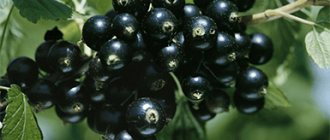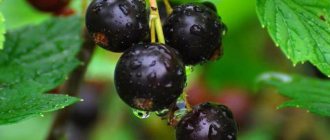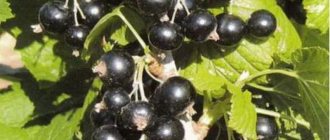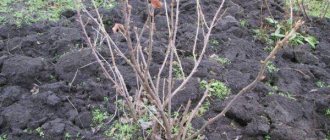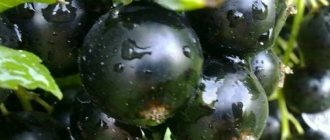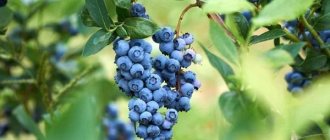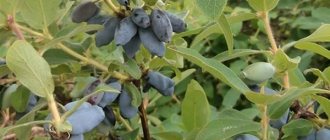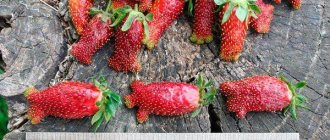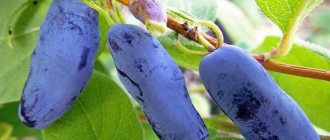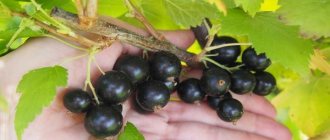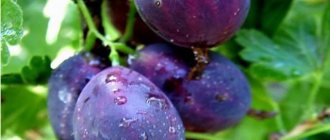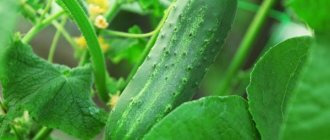Main advantages and disadvantages
Nara is drought-resistant and immune to low temperatures. The collected berries can be stored for a long time without becoming deformed.
Gardeners note the high taste qualities of Nara.
Blackcurrant of the declared variety adapts to any type of soil and ripens early. Thanks to the efforts of breeders, the plant is resistant to attack by insects and other pests and does not require pollination. Berries are low in calories and contain many beneficial microelements:
- magnesium;
- phosphorus;
- potassium;
- vitamins H, E, B2, B4, B
Negative characteristics. Any excess moisture is detrimental to the plant.
The bush produces an average harvest; the variety is not especially grown for sale.
Main positive and negative aspects
Nara currant has proven itself to have positive properties:
- Resistance to fungal diseases and pests.
- Tolerates frosts.
- High yield compared to other varieties.
- Early ripening.
- High content of vitamin C – 179 milligrams per 100 grams of product.
- Harmonious ripening of berries.
- Does not require pollination.
Flaws:
- Does not tolerate the climate of the southern regions well.
- Early flowering. Subject to frost.
Minimal disadvantages do not eliminate all the benefits of Nara currants.
Botanical information and characteristics of the variety
The Nara variety has long established itself among experienced gardeners. In order to understand why currants are so popular, let’s look at their characteristics.
Bush and root system
The medium-sized bush is compact, reaching a height of 1.5 m. The root system is close to the surface.
Sheet plates
The leaf blade is light green and convex to the touch. The wrinkled, pubescent leaves are large in size.
Flowering and pollination
Nara can be recognized by its pale red inflorescences. One brush produces up to 10 flowers. The plant is a self-fertile crop.
Fruit ripening time
Ripening occurs at the beginning of June. In areas with low temperatures, flowers may be damaged by frost. Already in July, the harvest can be harvested.
Taste and yield
Currant berries are matte, have a sweet and sour taste, and ripen at the same time. Weight - about 3 g. Nara's yield is average, up to 15 kg of fruits are collected from one bush.
Taste rating: 4.3 points.
See also
What fertilizers are best to feed currants for a better harvest?
Read
Storage rules and scope of application of berries
Thanks to the thick peel, Nara is well stored and does not burst when poured. It is better to place it in a refrigerator or basement with a temperature of up to +14 °C.
The berries are suitable for freezing for the winter, for eating fresh, and for making preserves, compotes and jams.
Resistance to negative temperatures and drought
Nara currants do not tolerate dry climates, so they are not intended for cultivation in the southern regions.
The plant is not afraid of negative temperatures during the fruiting process. But frosts at the beginning of flowering can destroy the bush.
Susceptibility to diseases and pests
The variety is resistant to gray rot, anthracnose, mosaic and powdery mildew. But preventative measures never hurt. In rare cases, the bush is attacked by aphids and spider mites. Chemicals are used against them.
Features of cultivation
Landing site requirements
Blackcurrant Gulliver
Currant bushes develop best in well-lit areas. Dense shade leads to a deterioration in taste, the fruits grow too sour. The plant should also be protected from wind and drafts, so it is permissible to plant currants along walls and fences with a southern or southwestern orientation.
Soil preparation
Loams are optimal for planting; in clay and sandy soils, the plant very much slows down in development and loses productivity. Despite the fact that the plant loves moist soil, swampy lowlands or close proximity to groundwater are not suitable for cultivation, as the roots are likely to rot. Acidic soils are also not suitable for currants; they need to be limed with dolomite flour (300-400 g/m2).
Choosing a landing method
If the variety is intended to be bred for the first time, then it is best to purchase planting material from a nursery. Before purchasing, the seedling should be carefully inspected. Branches and leaves should look healthy. Be sure to check the leaves on both sides for the presence of pest larvae or fungal spots. The root system also needs to be examined. The presence of rotten black roots is not allowed. A good strong seedling should be about 0.3 m tall, the roots should be at least 0.2 m, the number of active buds should be at least 3 pieces. If there are already Nara bushes on your personal plot, then you can obtain planting material in 3 ways:
- By layering. In the spring, the healthiest shoot is placed in pre-dug furrows, fixed and covered with earth. It is watered all summer, and in the fall it is separated from the parent bush;
- By cuttings. This planting material is formed in the summer, when young shoots grow from the bush. At the base of the plant, cuttings 1 cm thick and 2 cm long are cut and placed either in containers or in a greenhouse. By autumn, the shoots should take root, which means they can be planted in a permanent place;
- Dividing the bush. This is the simplest method, in which the root system is divided into 2 parts and planted in separate holes. The division site must be sprinkled with wood ash.
Landing
Autumn planting is considered the most favorable, then the bush is guaranteed to take root and take root. Planting in spring is also allowed, but seedlings are not always accepted. In autumn, currants are planted when the leaves fall, in spring - when the soil warms up to +10˚C. The bushes are planted at a distance of 1.5 m from each other. The size of the planting pit is 0.4 * 0.5 m. The first to lay out an organomineral complex on the bottom: compost or rotted manure (10 kg), ash (3 l) and superphosphate (70 g). The next layer is planting soil. Next, the pit is watered with 5 liters of water. The seedling is placed in the center, covered with soil and pressed down tightly, adding the required amount of soil. Then water again with another 5 liters of water. The tree trunk circle is mulched with peat, humus or manure.
Planting with manure
Care
To obtain a high yield, certain conditions must be met:
- Watering. Nara tolerates drought well. At the same time, during key periods of plant development, watering should be sufficient and regular. Lack of moisture at the time of budding and flowering leads to drying out and falling off of the ovaries. An increase in fruit mass under drought conditions leads to the fact that the berries become smaller and have a sour taste. Accordingly, it is enough to water the bush three times a season. The water consumption rate is 30 liters for 1 bush. Warm, settled water is suitable for irrigation. In particularly dry regions, you can water the currants every week. Each watering should be accompanied by loosening the tree trunk and removing weeds. This will improve root aeration and water will not stagnate;
- Feeding. In the first 2 years after planting, currants do not need additional feeding. The complex that was introduced into the planting hole is enough for her. From the third year, fertilizing should be applied on an ongoing basis in spring and autumn. In the fall, it is enough to add organic matter (manure, compost). In spring, fertilizing is done in 3 stages:
- To develop the green mass of the plant, nitrogen must be added;
- At the time of flowering, 2 liters of nitroammophoska solution are added to the root (concentration - 3 tablespoons per 10 liters of water);
- When the fruits begin to form, the currants are fed with potassium and phosphate fertilizers.
Trimming
This is an important stage in plant care, as it directly affects the development of the bush as a whole. Trimmings serve different purposes:
- Formative pruning is needed to prevent the bush from growing too much. Excess small shoots take away nutrition, but do not produce a harvest. An adult bush should have no more than 7 main branches and no more than 20 shoots. All small growth must be removed;
- Sanitary pruning is carried out in order to remove broken, dry, diseased or old branches.
Advice! To prevent the bush from thickening, pruning should always be done on the outer bud. There should be 3-5 buds on each branch.
Diseases and pests
Nara currants have high immunity to all diseases: blight, powdery mildew, gray rot, anthracnose, rust, mosaic. At the same time, preventive measures will never be superfluous. First of all, after the leaves fall, the area needs to be cleaned; all leaves and branches are raked out from the under-stem circle and burned. It is in last year's plant remains that fungal diseases overwinter and develop. In the spring, before the growing season begins, and in the fall, after the leaves fall, you can spray the bushes with a solution of copper sulfate (100 g per 10 liters of water). This product protects the bush from fungus, insects and putrefactive processes, and increases productivity.
Nara is sometimes attacked by spider mites, aphids and gall midges. When a bush is attacked by insects, the best way to combat them is chemicals.
It is important to know! Any chemical composition can be toxic to humans, so such products should be used only before flowering begins, then you need to take a break. If the insects have not disappeared, then spraying can be continued, but 20 days before harvesting, the procedures must be stopped. Karbofos and Fofamid fight insects best.
How to plant Nara currants on a plot
Further fruiting of currants depends on proper placement. Nara can safely produce crops for 15-20 years.
Deadlines
The seedling is planted in the fall, when the leaves have already fallen. Or in the spring after the snow melts into the sun-warmed ground, when the temperature stabilizes.
It is recommended to plant in the fall. This way the currants will have time to take root before flowering.
Landing site requirements
The planting site should be sunny and well protected from winds. The less light the plant receives, the more sour the fruits will grow. The sides are chosen from the south, southwest.
Wet sandy soil will slow down the development of currants and the yield will be low. Loam is ideal. Purely clay soil will reduce the yield and development of the bush itself. Acidic soils will not do any good; they need to be limed first.
Seedling preparation and work procedure
In order for the bush to please you with a rich harvest in the future, choose a strong seedling. Plant currants in loose prepared soil. Excessively moist soil is diluted with river sand.
Algorithm for planting Nara currants:
- Dig a hole 50 cm deep.
- The bottom of the pit is covered with humus (2 buckets) and wood ash (3 liters).
- Soil is poured next
- The earth must settle, the hole is left for 21 days.
- If the seedling has dry leaves or damaged roots, then get rid of them by carefully cutting them off with a knife.
- The seedling is placed in the center of the hole, the roots are sprinkled with soil, and watered.
- The shoot is cut so that no more than 15 cm is left above the ground.
After planting, you need to water the currants once a week, not more often. Before winter, the seedling is hilled up and covered with fallen leaves of garden trees.
Description of the blackcurrant variety Nara
The bushes of this species are medium-sized and slightly spreading. This allows them to be planted close to each other in a row. Young shoots of Nara black currant are curved, light green in color, with a matte, slightly pubescent surface. As they mature, they become lignified and acquire a gray-brown tint.
Nara's leaves are three-lobed, large, dark green in color. The surface of the plates is leathery, slightly convex, wrinkled. The blades have medium cutouts and their ends are pointed. There is a shallow, open notch at the base of the leaves. The serration along the edge of the plates is short.
The flowers of the black currant variety Nara are medium in size, as are the sepals. Petals are pale reddish in color. The fruit raceme is loose, sinuous, pubescent, containing 6-10 ovaries. The flowering period of the bush begins in May and lasts about two weeks.
Important! The lifespan of Nara blackcurrant bushes is 15-20 years.
The berries of this variety are large, the weight of each of them varies between 1.9-3.3 g. They have a round, regular shape, one-dimensional in the cluster. When ripe, the surface of the fruit becomes uniformly black and shiny. The berries have a long stalk with a dry detachment. The taste is sweetish, with a pronounced sourness. The tasting score is 4.6 points out of a possible five.
Important! The content of ascorbic acid in black currant fruits of the Nara variety reaches 159 mg per 100 g.
This species is self-fertile, so it does not need additional pollinators. But close planting of other varieties can have a beneficial effect on its yield.
The fruits of black currant variety Nara do not fall off when ripening for a long time
Further care for currants
The harvest will primarily depend on the care of the plant. The bush must be watered and periodically fed, and the branches must be pruned.
Watering mode
Black currants like frequent watering. A slight drought does not harm Nara, but it is better not to aggravate the situation. If there is insufficient moisture, the berries become smaller and fall off quickly. Ideally, 3 buckets of pre-settled water are poured under each bush.
See also
Description and cultivation of currant varieties Dar Smolyaninova
Read
During drought, watering is done 2 times a week.
Loosening and mulching the soil
After watering, the soil is loosened. This way the water reaches the roots faster. Be sure to remove weeds that may interfere with the currants.
Fertilizer application
Top dressing of currants begins in the third year after planting. Fertilizers containing nitrogen are used, which is responsible for the formation of foliage.
When flowers and berries appear on currants, nitrogen is not added.
During the flowering period, fertilizers prepared at home are applied, and an infusion of potato peels is prepared. Throw the peel into boiling water and leave covered with a lid. After cooling, water the bush with the solution.
Pruning: formative, sanitary, rejuvenating
Bush pruning is done in the fall. This way the bush will rejuvenate and produce a harvest. Affected, old shoots and leaves are removed.
With the onset of spring, branches damaged by frost are removed. Excess branches can shade the fruits, and the berries will not gain strength. Therefore, the more compact the bush, the better.
Dousing and hardening off bushes
Only resistant seedlings will be able to withstand the drop in temperature. Some gardeners apply fertilizer at the end of August. This should not be done, since the currants should stop growing at this time, but the opposite happens.
It is recommended to harden the bush with boiling water. This is done in order to avoid attacks by insects and pests.
Preventive seasonal treatments
All seasonal treatments are carried out after fruiting has ended, or before buds set.
How to cover plantings for the winter
There is no need to wrap Nara in cellophane for the winter. Simply sprinkle with mulch.
Landing
For Nara blackcurrants, you should choose a sunny, open place, protected from drafts. With a lack of light, the shoots of the bush become elongated, and the yield sharply decreases. This variety is undemanding to soil composition, but it shows maximum productivity when grown on loam with good aeration.
Important! For the bush to fully develop, it is necessary that the groundwater level in the area be at least 1.0 m.
Nara black currants should be planted in the fall, which will allow them to develop a good root system. Two weeks before this, you need to dig up the area and add 10 kg of humus per 1 square meter to the soil. m. You should also make a hole measuring 60 by 60 cm and fill it 2/3 of the volume with nutritious soil mixture. To prepare it, mix turf, leaf soil, peat, sand in a ratio of 2:1:1:1. Also add an additional 40 g of superphosphate and 25 g of potassium sulphide per seedling and thoroughly mix the fertilizers with the soil.
For planting, you need to choose two-year-old plants that have at least three shoots and a well-developed root system. Seedlings should not have signs of disease or mechanical damage. A day before the procedure, place the plants in water or water them abundantly to activate metabolic processes in the tissues. Blackcurrant seedlings of the Nara variety should be planted in a row at a distance of 1 m.
Landing algorithm:
- Place the seedling in the center of the planting hole.
- Spread out the roots.
- Sprinkle them with earth, fill all the voids.
- Compact the soil at the base.
- Water generously.
Important! When planting, the root collar of the Nara blackcurrant needs to be deepened by 5-7 cm, which contributes to the rapid growth of the shrub.
Aftercare
Watering the plant is necessary only in the absence of seasonal precipitation for a long time. Moisturize at the root at the rate of 10-20 liters, depending on age. Black currants of the Nara variety need to be fed from the second year after planting. To do this, use organic matter in the spring, and during the period of flowering and fruit formation - phosphorus-potassium mineral fertilizers.
For abundant fruiting, the bush should contain 15-20 branches, no more than 4-5 years old. Therefore, every spring you need to cut out old shoots at the base, and also clean black currants from damaged and broken branches after winter. Every six years, the Nara bush should be cut off at the base for rejuvenation.
The shoots of this variety can easily withstand the load during the berry ripening period, so they do not need to be tied to a support.
Nara blackcurrant seedlings need to be covered for the winter only in the first year after planting. To do this, you should lay mulch from peat or humus at their base in a layer of 5-7 cm, and wrap the upper part with agrofibre.
To protect against rodents, the lower part of the Nara blackcurrant bushes should be wrapped in roofing material and covered with spruce branches.
Diseases and pests
Nara blackcurrant has high immunity to powdery mildew and blight. In this case, you need to follow the rules of care in order to increase the body's defenses.
For preventive purposes, the bush should be treated from time to time with copper-containing preparations. Typically, treatment is carried out in early spring, and also after the harvest is harvested. Popular insect pests include spider mites, aphids and others. If you notice insects or see signs of their presence, then it is necessary to treat the plants with preparations such as Karbofos or Phosfamide. Care should be taken not to use chemicals 3 weeks before harvest.
Black currant in Memory of Potapenko: characteristics and features of the variety
The black currant variety Pamyati Potapenko is a representative of mid-season varieties, with a ripening period in July. The shrub has an average height, up to about 120 centimeters, a semi-spreading crown, with a circumference of about 70-80 centimeters. The young shoots of this bush are erect, endowed with an average thickness and a pale green color. The most mature, woody stems are curved at the base of the bush and have a grayish-brown tint.
The foliage of the Pamyat Potapenko currant has three lobes, and they are quite clearly defined. The leaf is medium in size, approximately 5 centimeters, dark green in color, and such leaves are located alternately on the stem. The leaf blade has a matte surface and is bare, leathery, has a weak wrinkled structure, with pointed and short teeth. The leaf has a straight base, with a rather small notch. The petiole is dark green in color, has an average length of three to five centimeters, and has a crimson color in the groove.
When opening, the flowers are small in size, approximately reaching 8 millimeters, bisexual, and have a light green tint. The flowering period occurs in the month of May. They bloom in clusters of 15-20 flowers on average. The sepals are bent upward. The brushes are elongated, on average 6-7 centimeters. This shrub is considered self-pollinating, which means that fruits are formed on one such variety. When ripe, the fruits are large in size, round in shape and black in color with a natural bluish tinge. Each berry can weigh two to three grams and is 1.2 centimeters in circumference. The inner part of the fruit contains from three to twelve seeds. The period of fruit ripening occurs in the middle of the summer season, approximately 90-100 days after pollination. Separating the berries from the brush when picking is dry. The stalk is of medium size, thin and pale green in color.
The fruits of the Pamyat Potapenko currant are on drooping clusters. Under good conditions during the growing season and with the fewest number of berries on this plant, the fruits are larger, since there is no competition for micronutrients. The surface of the fruit is covered with a fairly dense skin, due to which the berries have good transportability and preservation. This crop of this subspecies can be harvested by mechanization. The berries themselves are soft, sweet in taste, with a small amount of sourness. During tasting, these berries received a score of 4.5 points out of five possible. In their composition, quite balanced, they have: sugars 7.2 percent, acids 2.2 percent.
This black currant in Memory of Potapenko is also a fast-growing plant with simultaneous ripening of its fruits. The average yield is three to four kilograms per bush. If we consider the yield on an industrial scale, the average will be approximately five tons per hectare.
The black currant variety Pamyati Potapenko has fairly good immunity to common and dangerous diseases such as powdery mildew and anthracnose, an average level of immunity to hazel grouse and septoria, as well as high resistance to the most common enemy of currants - the bud mite. According to experienced gardeners, this subspecies of the fruit and berry crop in question is endowed with a high level of frost resistance of flower buds and shoots.
Thanks to its unique composition of biological active substances, this plant is endowed with useful and medicinal properties; it contains (per 100 grams): calorie content - 63 kcal, proteins - 1.3 grams, fats - 0.4 grams, carbohydrates - 15.3 grams, water – 83.2 grams, ash – 0.9 grams, dietary fiber – 4.7 grams. According to its chemical composition, the berry contains (per 100 grams of product): vitamin E (alpha tocopherol) 1 milligram, vitamin C (ascorbic acid) 181 milligrams, vitamin B6 (pyridoxine) 0.07 milligrams, vitamin B5 (pantothenic acid) 0.4 approximately milligrams, vitamin B2 (riboflavin) 0.05 milligrams, vitamin B1 (thiamine) 0.05 milligrams. The fruits also contain a large amount of macro- and microelements (per 100 grams of product): calcium 55 milligrams, iron 1.53 milligrams, magnesium 24 milligrams, manganese 0.26 milligrams, zinc 0.27 milligrams, sodium 2 milligrams, potassium 322 milligrams , phosphorus 59 milligrams.
It is worth noting that in terms of the amount of vitamin C, potassium and phosphorus in their composition, the fruits of this subspecies are superior to most fruits. They can only give way to elderberry in terms of the amount of protein and iron, and also have the lowest fat content in comparison with other berries.
Cleaning and storage rules
Nara currants ripen together. Collection is carried out in dry weather, when the dew has subsided. They pick the berries by the handful. They are sorted and prepared for storage.
The berry is stored for 2 weeks at an air temperature of 12 degrees, humidity - 40-60%. Deviation from the norm in one direction or another leads to rot or dryness of the fruit.
If favorable conditions are created, the shelf life can be increased to 20 days. Distribute the dry berries into boxes and send them to a room with a temperature of 0 or minus 1 degree. In plastic bags, without access to oxygen, the period is extended to 1 month. Currants are also stored in the freezer, dry, canned.
